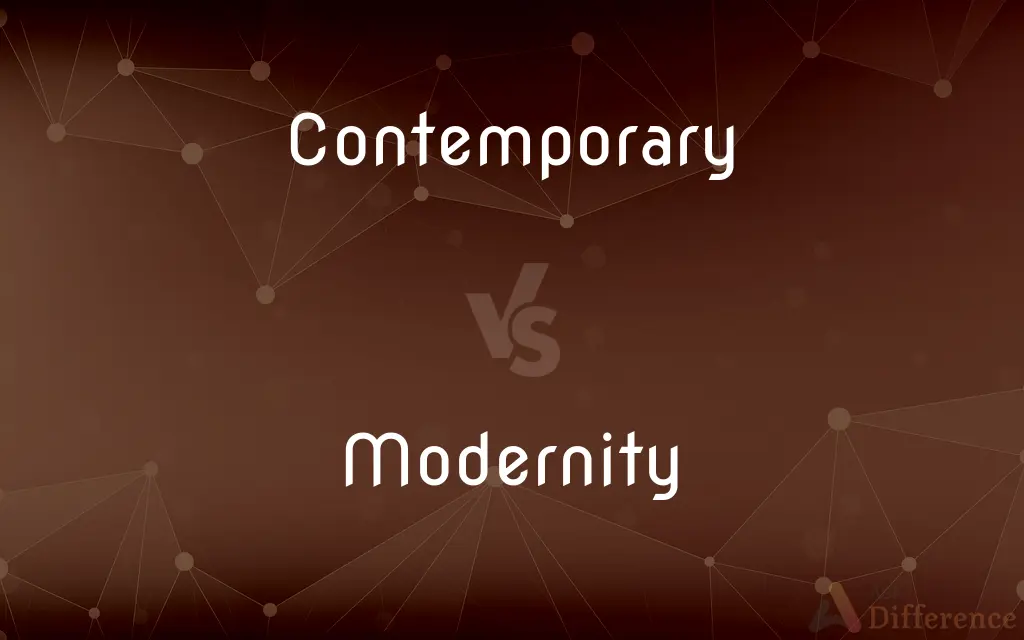Contemporary vs. Modernity — What's the Difference?
Edited by Tayyaba Rehman — By Maham Liaqat — Updated on April 6, 2024
Contemporary refers to anything related to the present time, while modernity signifies the cultural, intellectual, and societal changes associated with the modern era.

Difference Between Contemporary and Modernity
Table of Contents
ADVERTISEMENT
Key Differences
Contemporary, in its broadest sense, refers to the current time or period, encompassing current trends, ideas, and characteristics of the present-day society. Modernity, however, denotes a historical period marked by significant changes in various domains such as technology, culture, and philosophy, primarily emerging from the Enlightenment onwards.
While contemporary art, literature, or music directly reflect the styles and themes prevalent in today's society, modernity is often associated with the broader movements that began in the late 19th and early 20th centuries, emphasizing reason, scientific rationality, and progress.
Contemporary issues or events are those happening now or recently, showing direct relevance to the current societal context. In contrast, modernity involves the ongoing effects of the modern era's transformative events and ideas, such as industrialization, secularization, and the rise of democratic ideals.
The term contemporary can apply to any period that is considered "current" from the perspective of the speaker, and it continuously evolves. Modernity, while it also evolves, is more fixed in its historical context, relating to the profound societal shifts that have long-term impacts on civilization.
In practice, something contemporary is directly tied to the time frame it exists in, often without a specific historical connotation beyond its present relevance. Modernity, conversely, carries a narrative of historical progression, embodying the transition from traditional to modern societies with an emphasis on the future.
ADVERTISEMENT
Comparison Chart
Definition
Pertaining to the present time or period
The cultural, societal, and intellectual era and changes starting from the Enlightenment
Focus
Current trends, ideas, and technology
Historical period and its long-term impacts on society
Examples
Contemporary art, literature, current events
Industrial revolution, secularization, democracy
Time Frame
The present moment, continuously evolving
Historical period, more fixed but evolving in understanding
Contextual Emphasis
Immediate relevance to current societal context
Broad societal transformations and their effects
Compare with Definitions
Contemporary
Current Time Period.
Contemporary architecture incorporates sustainable materials.
Modernity
Historical Changes.
Modernity is marked by the widespread impact of the industrial revolution.
Contemporary
Present-Day Society.
Contemporary issues often reflect global concerns.
Modernity
Intellectual Movement.
Enlightenment thinkers laid the groundwork for modernity.
Contemporary
Immediate Relevance.
Contemporary politics are heavily influenced by social media.
Modernity
Cultural Shifts.
The move towards secularization is a key aspect of modernity.
Contemporary
Evolving Nature.
The definition of contemporary art evolves with societal changes.
Modernity
Societal Transformation.
Modernity introduced significant changes in social structures and norms.
Contemporary
Current Trends.
Contemporary music genres like EDM are popular worldwide.
Modernity
Long-term Impact.
The concepts of democracy and human rights are pillars of modernity.
Contemporary
Living or occurring at the same time
The event was recorded by a contemporary historian
Modernity
The state or quality of being modern
"Warriors of the ... tribe, imposing symbols of a nomadic culture ... are caught between tradition and modernity" (Sheila Rule).
Contemporary
Belonging to or occurring in the present
The tension and complexities of our contemporary society
Modernity
The quality of being modern or contemporary.
He was impressed by the architecture's modernity.
Contemporary
A person or thing living or existing at the same time as another
He was a contemporary of Darwin
Modernity
Modern times.
The organization survived from ancient times to modernity.
Contemporary
Belonging to the same period of time
A fact documented by two contemporary sources.
Modernity
(history) Quality of being of the modern period of contemporary historiography.
Contemporary
Of about the same age.
Modernity
Modernness; something modern.
Contemporary
Current; modern
Contemporary trends in design.
Modernity
The quality of being current or of the present;
A shopping mall would instill a spirit of modernity into this village
Contemporary
One of the same time or age
Shelley and Keats were contemporaries.
Contemporary
A person of the present age.
Contemporary
From the same time period, coexistent in time; contemporaneous.
Contemporary
Modern, of the present age (shorthand for ‘contemporary with the present’).
Contemporary
Someone or something living at the same time, or of roughly the same age as another.
Cervantes was a contemporary of Shakespeare.
The early mammals inherited the earth by surviving their saurian contemporaries.
Contemporary
Something existing at the same time.
Contemporary
(dated) A rival newspaper or magazine.
Contemporary
Living, occuring, or existing, at the same time; done in, or belonging to, the same times; contemporaneous.
This king [Henry VIII.] was contemporary with the greatest monarchs of Europe.
Contemporary
Of the same age; coeval.
A grove born with himself he sees,And loves his old contemporary trees.
Contemporary
One who lives at the same time with another; as, Petrarch and Chaucer were contemporaries.
Contemporary
A person of nearly the same age as another.
Contemporary
A person of nearly the same age as another
Contemporary
Characteristic of the present;
Contemporary trends in design
The role of computers in modern-day medicine
Contemporary
Belonging to the present time;
Contemporary leaders
Contemporary
Occurring in the same period of time;
A rise in interest rates is often contemporaneous with an increase in inflation
The composer Salieri was contemporary with Mozart
Common Curiosities
Can something be both contemporary and part of modernity?
Yes, elements can be both if they are current and also reflect the long-term changes associated with the modern era.
Why is modernity considered a significant historical period?
Modernity is significant due to its transformative impacts on society, including technological advancements, shifts in cultural norms, and the development of new political and philosophical ideas.
How do contemporary technologies influence society?
Contemporary technologies, such as digital communication, AI, and renewable energy, significantly influence societal norms, economic structures, and personal interactions.
What challenges does modernity present to traditional societies?
Modernity challenges traditional societies by questioning established norms, promoting secular and democratic values, and introducing rapid technological change.
How does contemporary art differ from modern art?
Contemporary art is created in the present day, focusing on current themes, while modern art refers to artistic works produced during the modern era, highlighting the changes and styles of that period.
What is the impact of contemporary social media on modernity?
Social media has transformed communication, social interaction, and information dissemination, reflecting and shaping the continuing evolution of modernity.
How is contemporary culture influenced by modernity?
Contemporary culture is shaped by the ideals and innovations of modernity, including the emphasis on individualism, progress, and global interconnectedness.
Can contemporary issues become part of the study of modernity?
Yes, contemporary issues that have a lasting impact on society may eventually be studied as part of modernity's ongoing narrative.
Is modernity a global phenomenon?
While modernity began in the West, its influences are global, affecting societies worldwide through cultural exchange, colonization, and globalization.
What role does secularization play in modernity?
Secularization, or the decline of religious authority in public and private life, is a key component of modernity, reflecting the shift towards reason and scientific understanding.
How does contemporary literature explore themes of modernity?
Contemporary literature explores themes of modernity such as identity, technology, and social change, reflecting on the complexities of the modern world.
How do contemporary political movements reflect modernity?
Contemporary political movements often reflect modernity's values, such as equality, freedom, and human rights, while addressing current global and local issues.
Can contemporary education systems reflect principles of modernity?
Yes, contemporary education systems often embody modernity's principles by promoting critical thinking, secular knowledge, and preparing individuals for a globalized world.
How do modernity and postmodernity differ?
Postmodernity critiques and responds to modernity, questioning its narratives of progress and certainty and emphasizing diversity, skepticism, and the subjective nature of knowledge.
Share Your Discovery

Previous Comparison
Multilingual vs. Polylingual
Next Comparison
Relevant vs. RelatedAuthor Spotlight
Written by
Maham LiaqatEdited by
Tayyaba RehmanTayyaba Rehman is a distinguished writer, currently serving as a primary contributor to askdifference.com. As a researcher in semantics and etymology, Tayyaba's passion for the complexity of languages and their distinctions has found a perfect home on the platform. Tayyaba delves into the intricacies of language, distinguishing between commonly confused words and phrases, thereby providing clarity for readers worldwide.
















































